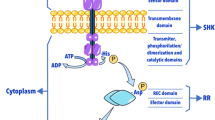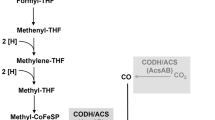Abstract
ThePHO84 gene inSaccharomyces cerevisiae encodes a Pi transporter, mutation of which confers constitutive synthesis of repressible acid phosphatase (rAPase), in medium containing repressible amounts of Pi, and an arsenate-resistant phenotype. We selected an arsenate-resistant mutant showing the constitutive synthesis of rAPase on nutrient plates containing 4.5 mM arsenate. This mutant has double mutations designated aspho86 andpho87. The mutant transcribesPHO84 even in the repressible condition but has a severe defect in Pi uptake. The constitutive rAPase+ phenotype of thepho86 pho87 mutant was partially suppressed by an increased dosage of thePHO84 gene. ThePHO87 gene was found to be identical withYCR524, according to the published nucleotide sequence of chromosome III, which encodes a protein of 923 amino-acid residues with a highly charged N-terminal half followed by a C-terminal half consisting of 12 membrane-spanning segments as in Pho84p. These and the other findings suggest that the Pho86p and Pho87p proteins collaborate with Pho84p in Pi uptake.
Similar content being viewed by others
References
Bennett RL, Malamy MH (1970) Arsenate resistant mutants ofEscherichia coli and phosphate transport. Biochem Biophys Res Commun 40:496–503
Bowman BJ, Allen KE, Slayman CW (1983) Vanadate-resistant mutants ofNeurospora crassa are deficient in a high-affinity phosphate transport system. J Bacteriol 153:292–296
Bun-ya M, Nishimura M, Harashima S, Oshima Y (1991) ThePHO84 gene ofSaccharomyces cerevisiae encodes an inorganic phosphate transporter. Mol Cell Biol 11:3229–3238
Bun-ya M, Harashima S, Oshima Y (1992) Putative GTP-binding protein, Gtr1, associated with the function of the Pho84 inorganic phosphate transporter inSaccharomyces cerevisiae. Mol Cell Biol 12:2958–2966
Chant J, Corrado K, Pringle JR, Herskowitz I (1991) YeastBUD5, encoding a putative GDP-GTP exchange factor, is necessary for bud-site selection and interacts with bud-formation geneBEM1. Cell 65:1213–1224
Clarke L, Carbon J (1978) Functional expression of cloned yeast DNA inEscherichia coli: specific complementation of argininosuccinate lyase (argH) mutations. J Mol Biol 120:517–532
Eisenberg D (1984) Three-dimensional structure of membrane and surface proteins. Annu Rev Biochem 53:595–623
Fogel S, Welch JW (1982) Tandem gene amplification mediates copper resistance in yeast. Proc Natl Acad Sci USA 79:5342–5346
Johnson DL (1971) Simultaneous determination of arsenate and phosphate in natural waters. Environ Sci Technol 5:411–414
Kanik-Ennulat C, Neff N (1990) Vanadate-resistant mutants ofSaccharomyces cerevisiae show alterations in protein phosphorylation and growth control. Mol Cell Biel 10:898–909
Kyte J, Doolittle RF (1982) A simple method for displaying the hydropathic character of a protein. J Mol Biol 157:105–132
Lehle L, Bause E (1984) Primary structural requirements forN- andO-glycosylation of yeast mannoproteins. Biochim Biophys Acta 799:246–251
Lindegren G, Hwang YL, Oshima Y, Lindegren CC (1965) Genetical mutants induced by ethyl methanesulfonate inSaccharomyces. Can J Genet Cytol 7:491–499
Maniatis T, Fritsch EF, Sambrook J (1982) Molecular cloning: a laboratory manual. Cold Spring Habor Laboratory, Cold Spring Habor, New York
Mortimer RK, Contopoulou CR, King JS (1992) Genetic and physical maps ofSaccharomyces cerevisiae, edition 11. Yeast 8:817–902
Ogawa N, Noguchi K, Yamashita Y, Yasuhara T, Hayashi N, Yoshida K, Oshima Y (1993) Promoter analysis of thePHO81 gene encoding a 134-kDa protein bearing ankyrin repeats in the phosphatase regulon ofSaccharomyces cerevisiae. Mol Gen Genet 238:444–454
Ogawa N, Hayashi N, Saito H, Noguchi K, Yamashita Y, Oshima Y (1994) Regulatory circuit for phosphatase genes inSaccharomyces cerevisiae: specificcis-acting sites inPHO promoters for binding the positive regulator Pho4p. In: Torriani-Gorini A, Yagil E, Silver S (eds) Phosphate in microorganisms: cellular and molecular biology. American Society for Microbiology; Washington DC, pp 56–62
Ogawa N, Noguchi K, Sawai H, Yamashita Y, Yompakdee C, Oshima Y (1995) Functional domains of Pho81p, an inhibitor of Pho85p protein kinase, in the transduction path way of P1 signals inSaccharomyces cerevisiae. Mol Cell Biol 15:997–1004
Parent SA, Fenimore CM, Bostian KA (1985) Vector systems for the expression, analysis and cloning of DNA sequences inS. cerevisiae. Yeast 1:83–138
Perkins DD (1949) Biochemical mutants of the smut fungusUstilago maydis. Genetics 34:607–626
Philippsen P, Thomas M, Kramer RA, Davis RW (1978) Unique arrangement of coding sequences for 5S, 5.8S, 18S and 25S ribosomal RNA inSaccharomyces cerevisiae as determined by R-loop and hybridization analysis. J Mol Biol 123:387–404
Rothstein RJ (1983) One-step gene disruption in yeast. Methods Enzymol 101:202–211
Ray BL, White CI, Haber JE (1991) TheTSM1 gene ofSaccharomyces cerevisiae overlaps theMAT locus. Curr Genet 20:25–31
Tamai Y, Toh-e A, Oshima Y (1985) Regulation of inorganic phosphate transport systems inSaccharomyces cerevisiae. J Bacteriol 164:964–968
Thierry A, Fairhead C, Dujon B (1990) The complete sequence of the 8.2-kb segment left ofMAT on chromosome III reveals five ORFs, including a gene for a yeast ribokinase. Yeast 6:521–534
Ueda Y, Oshima Y (1975) A constitutive mutation,phoT, of the repressible acid phosphatase synthesis with inability to transport inorganic phosphate inSaccharomyces cerevisiae. Mol Gen Genet 136:255–259
Vieira J, Messing J (1987) Production of single-stranded plasmid DNA. Methods Enzymol 153:3–11
Willsky GR, Leung JO, Offermann Jr PV, Plotnick EK, Dosch SF (1985) Isolation and characterization of Vanadate-resistant mutants ofSaccharomyces cerevisiae. J Bacteriol 164:611–617
Yoshida K, Kuromitsu Z, Ogawa N, Oshima Y (1989a) Mode of expression of the positive regulatory genesPHO2 andPHO4 of the phosphatase regulon inSaccharomyces cerevisiae. Mol Gen Genet 217:31–39
Yoshida K, Ogawa N, Oshima Y (1989 b) Function ofPHO regulatory genes for repressible acid phosphatase synthesis inSaccharomyces cerevisiae. Mol Gen Genet 217:40–46
Yoshikawa A, Isono K (1990) Chromosome III ofSaccharomyces cerevisiae: an ordered clone bank, a detailed restriction map and analysis of transcripts suggest the presence of 160 genes. Yeast 6:383–401
Author information
Authors and Affiliations
Additional information
Communicated by M. Yamamoto
Rights and permissions
About this article
Cite this article
Bun-ya, M., Shikata, K., Nakade, S. et al. Two new genes,PHO86 andPHO87, involved in inorganic phosphate uptake inSaccharomyces cerevisiae . Curr Genet 29, 344–351 (1996). https://doi.org/10.1007/BF02208615
Received:
Issue Date:
DOI: https://doi.org/10.1007/BF02208615




